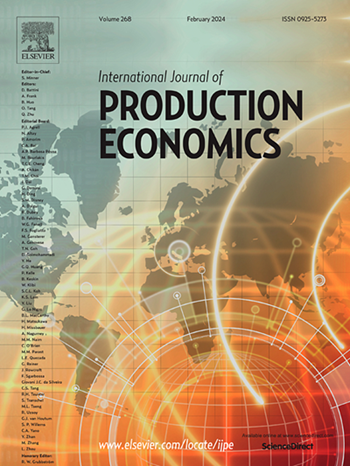时变需求下弹性多源订单分配中基于fp增长的双重成本风险缓解风险模式发现
IF 10
1区 工程技术
Q1 ENGINEERING, INDUSTRIAL
引用次数: 0
摘要
电子商务和全球化的迅猛发展增加了入站供应链弹性的复杂性,特别是在多源订单分配决策方面。尽管研究广泛,但传统方法往往不足以处理成本风险的双重最小化,特别是在面临动态变化的情况下。本研究旨在通过提出一种新颖的解决方案来填补这一空白,该解决方案同时解决时变需求下的订单分配的双重目标。我们方法的独特之处在于应用FP-Growth关联规则算法来发现基于标准相互依赖性的潜在风险模式。我们将该技术与加权和方法(WSM)的一种新变体相结合,提供了一个风险意识决策模型。基于汽车工业的实际案例研究,提出了一个数值应用来证明该方法的适用性。此外,为了适应数据可用性约束,我们提出了一种使用联合和条件概率分布(JCPD)方法的数据增强算法。该技术生成体积合成数据,同时保留属性(标准)之间的相互依赖性,从而支持实际验证。实验结果证明了该方案在各种场景下的有效性,突出了其优越性。这项研究提供了双重理论和管理意义。首先,介绍了人工智能驱动模型中用于实时风险建模的自下而上风险模式发现方法的理论理解。其次,它为购买者引入了一种实用的人工智能驱动的逐步方法,提高了新兴风险倾向市场的成本效率、弹性和主动降低风险。尽管取得了令人鼓舞的结果,但我们承认研究的局限性,并提出了未来的研究方向。本文章由计算机程序翻译,如有差异,请以英文原文为准。
FP-Growth-based risk pattern discovery for dual cost-risk mitigation in resilient multi-sourcing order allocation under time-varying demand
The huge growth of e-commerce and globalization has increased the complexity of inbound supply chain resilience, especially in multi-sourcing order allocation decisions. Despite extensive research, traditional methods often prove inadequate for handling the dual cost-risk minimization, particularly when confronted with dynamic changes. This research aims to fill this gap by proposing a novel solution that simultaneously tackles the dual objectives with order allocation under time-varying demand. The uniqueness of our approach lies in the application of the FP-Growth association-rules algorithm to uncover latent risk patterns based on criteria interdependency. We hybridize this technique with a new proposed variant of the Weighted Sum Method (WSM), offering a risk-aware decision-making model. A numerical application based on real-world case study from the automotive industry is proposed to demonstrate the applicability. Furthermore, to adapt to data availability constraints, we proposed a data augmentation algorithm using the Joint and Conditional Probability Distributions (JCPD) method. This technique generates volumetric synthetic data while preserving interdependencies between attributes (criteria), enabling realistic validation. Experimental results demonstrate the effectiveness of the proposed solution across various scenarios, highlighting its superiority. This research provides twofold theoretical and managerial implications. First, it introduces a theoretical understanding of a bottom-up risk-pattern discovery approach for real-time risk modelling in an AI-driven model. Second, it introduces a practical AI-driven stepwise approach for purchasers that enhances cost efficiency, resilience, and proactive risk mitigation in the emerging risk-prone markets. Despite the promising results, we acknowledge the limitations of our study and suggest future research directions.
求助全文
通过发布文献求助,成功后即可免费获取论文全文。
去求助
来源期刊
CiteScore
21.40
自引率
7.50%
发文量
266
审稿时长
52 days
期刊介绍:
The International Journal of Production Economics focuses on the interface between engineering and management. It covers all aspects of manufacturing and process industries, as well as production in general. The journal is interdisciplinary, considering activities throughout the product life cycle and material flow cycle. It aims to disseminate knowledge for improving industrial practice and strengthening the theoretical base for decision making. The journal serves as a forum for exchanging ideas and presenting new developments in theory and application, combining academic standards with practical value for industrial applications.

 求助内容:
求助内容: 应助结果提醒方式:
应助结果提醒方式:


